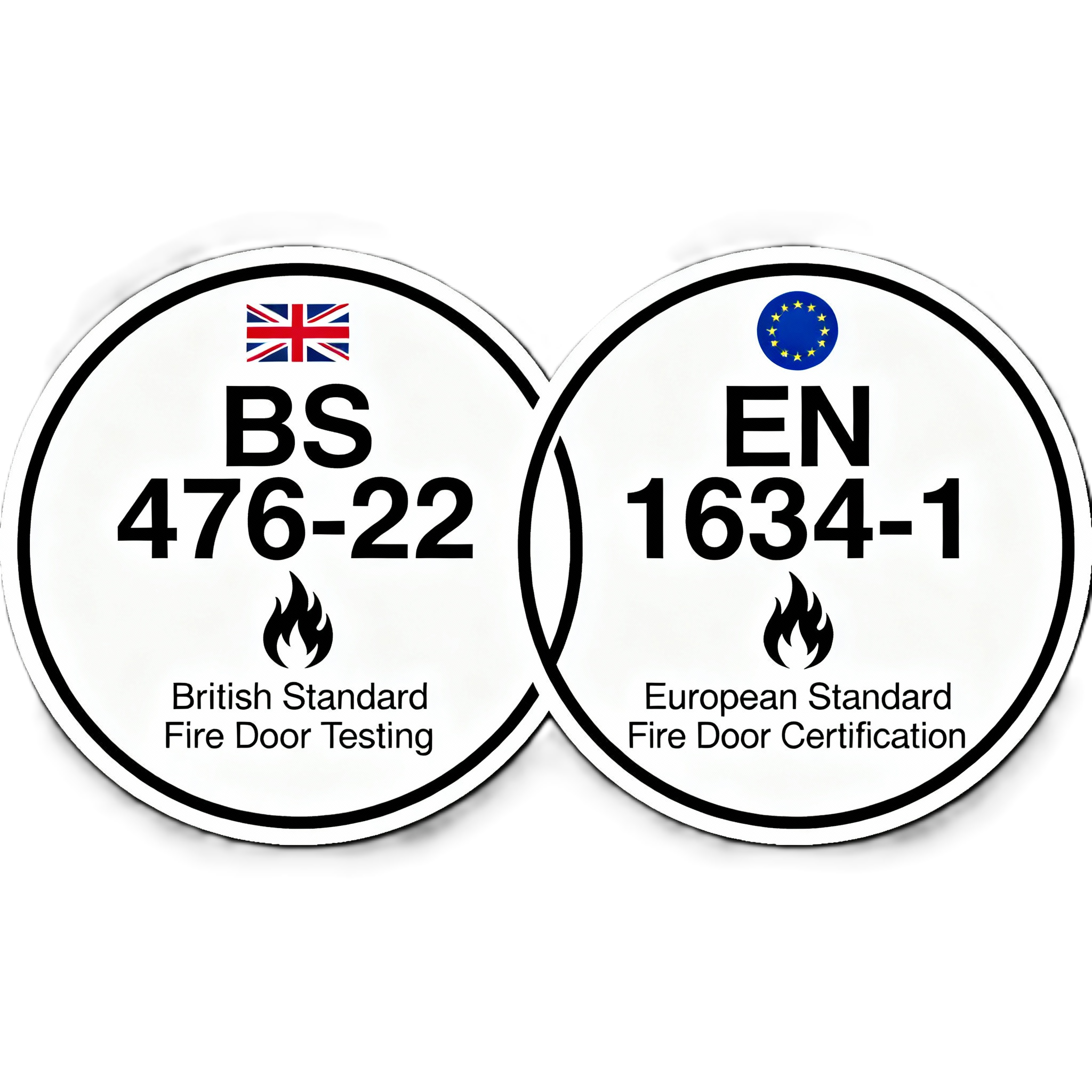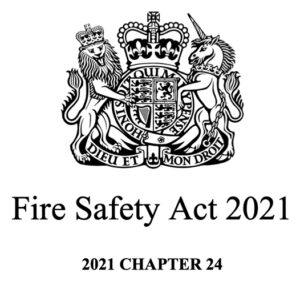A fire door inspection is a systematic examination of every fire door in a building against established compliance standards to verify they meet legal requirements and will function correctly in a fire emergency. This goes beyond a casual visual check. Inspectors assess the door leaf, frame, hardware, seals, glazing, gaps, and signage using a structured methodology based on British Standards such as BS 8214:2016, BS 9999, and the manufacturer's test evidence.
Fire doors are not simply security fixtures; they are engineered life-safety systems that contain fire and smoke to critical escape routes and compartmentalise buildings. Regular inspection by certified professionals is a legal requirement under the Regulatory Reform (Fire Safety) Order 2005 and the Fire Safety Act 2021. Without proper inspection and maintenance, even a certified fire door can lose effectiveness and become a compliance liability rather than a protection asset.
A fire door inspection checks that each door set will hold back fire and smoke for its rated duration. We verify structural integrity, sealing, and operation, helping you meet the Fire Safety Act 2021 and the Regulatory Reform Order 2005.
Fire door inspections serve three essential functions: legal compliance, life safety, and risk management. Under UK fire safety legislation, the Responsible Person for a building is legally required to ensure fire doors are correctly installed, maintained, and inspected at regular intervals. Failure to comply can result in prosecution, unlimited fines, and personal liability. Additionally, insurance policies often contain clauses requiring documented fire door maintenance and inspection records; without them, claims may be denied in the event of a fire.
Beyond legal requirements, fire doors are a critical component of your building's passive fire protection strategy. When properly maintained and inspected, they provide occupants with vital time to evacuate safely, limit the spread of fire and smoke to other areas, and reduce overall property damage. An inspection verifies that this protection is active and reliable.
Without regular inspection, even small faults can cause failure in an emergency. Arrow Industrial’s inspection service provides peace of mind and evidence for auditors and insurers. Our engineers assess every component for performance, ensuring your doors meet BS and EN standards.
According to industry data, more than 75% of fire doors inspected across the UK are found to be non-compliant, with common faults including excessive gaps exceeding tolerance limits, missing or damaged seals, faulty self-closing mechanisms, and incorrect or missing certification. These seemingly minor issues can significantly compromise fire resistance, potentially reducing protection from 30-60 minutes down to just 5-10 minutes.

Arrow's fire door inspection service includes a systematic evaluation of each door against current compliance standards. The inspection process covers the door leaf and frame integrity to identify warping, damage, or signs of tampering; hinges and door closers to confirm they are fire-rated, functioning correctly, and closing securely; signage and certification labels to verify compliance marking and "Fire Door Keep Shut" signage; door seals and gaps to measure clearances and check intumescent and smoke seals for damage or deterioration; glazing integrity on fire-rated glass to confirm correct seals and beading; and door locks to ensure they are functioning and fire-rated hardware is fitted correctly.
Following the initial site visit and door count, each door receives individual assessment against a detailed compliance checklist. Arrow provides detailed photographic evidence, a comprehensive written report indicating pass or fail status for each door, clearly identified remedial actions required to achieve compliance, and practical guidance on ongoing maintenance requirements.
Every inspection is thorough, recorded, and evidence-based. We assess:
• Door leaf and frame condition
• Hinges, closers and latches
• Intumescent and smoke seals
• Thresholds and gaps
• Vision panels and glazing
• Signage and certification labels
• Operation and self-closing performance
For replacement or upgrade needs, see our Fire Protection Doors or book an Installation visit.
Pre-inspection briefing and access plan
Door-by-door survey with measurements and photos
On-site notes for any immediate safety concerns
Report compiled and sent for review
Optional quotation for remedials or maintenance visits
Our engineers work efficiently to reduce disruption to your operations.
Each door set is documented in a digital report containing:
• Photographs of all components
• Defect list with risk level and priority
• Compliance rating
• Recommended remedial works
• Quotation for repairs or replacements
All information is provided in an easy-to-audit format that supports your Fire Risk Assessment.
Following inspection, we can complete any remedials needed to bring doors up to standard:
• Adjusting or replacing closers and hinges
• Refitting or upgrading seals
• Correcting excessive gaps
• Replacing damaged glazing beads or panels
• Adding compliant signage and labels
• Rehanging warped doors or installing new sets
If a door is beyond repair, we offer compliant Fire Protection Doors and Shutters supplied and fitted by our expert team.
Best practice guidance from the British Standards institution recommends that fire door inspections be carried out every 6 months in high-traffic areas and annually as a minimum for all other commercial premises. The Fire Safety (England) Regulations 2022 specifically requires quarterly checks for common areas in high-rise residential buildings, and this standard is increasingly applied across commercial premises as well.
The frequency of inspection should also account for the building's fire risk assessment and the usage patterns of the doors. Areas with high footfall, frequent door operation, or known risk factors may require more frequent inspection intervals to detect early signs of wear or damage.
Arrow Industrial can schedule recurring visits within a Service & Repair plan, keeping your records consistent and your building compliant year-round.
Fire doors in the UK are tested and certified to British Standard BS 476-22 and European Standard BS EN 1634-1, ensuring each door set performs as rated during a fire.
Typical fire resistance ratings include:
FD30 – Provides at least 30 minutes of protection, meeting the minimum requirement for most workplaces and public buildings.
FD60 – Offers 60 minutes of protection, often specified for higher-risk zones such as escape routes or plant rooms.
FD90 – Rated for 90 minutes, suitable for industrial or larger commercial premises.
FD120 – Delivers up to 120 minutes of resistance, used in critical infrastructure and specialist settings.
Under European testing, fire doors carry an EI classification: E stands for integrity, meaning the door resists the passage of flames, while I denotes insulation, showing its ability to limit heat transfer to the unexposed side.


Fire Safety (England) Regulations 2022 introduce specific inspection requirements. Commercial buildings must conduct:
Six-monthly professional inspections
Quarterly checks in high-traffic areas
Annual comprehensive assessments
Documentation of all inspections
Buildings over 11 metres require enhanced inspection protocols with qualified Fire Door Inspection Scheme (FDIS) professionals.
Inspections frequently reveal recurring issues that compromise fire door effectiveness. These include incorrect or missing fire door certification where doors lack proper FD30 or FD60 labelling; damaged doors or frames that have been warped, cracked, or altered; gaps greater than 4mm around door edges where standards specify maximum tolerances of 3-4mm on sides and top and 10mm at bottom unless otherwise specified; non-functioning or missing door closers that prevent self-closure; intumescent strips that have been painted over, damaged, or removed entirely; incorrect or incompatible door hardware such as hinges and locks that are not fire-rated or CE-marked; fire-rated glazing that has been replaced with standard glass; and lack of appropriate signage to identify fire doors clearly.
Each of these faults may appear minor in isolation but compounds the overall risk when multiple doors fail inspection criteria. A door with 5mm gaps, missing seals, and a non-functioning closer has lost the majority of its fire-stopping capability.

We serve a wide range of facilities across the UK, including:
• Warehouses and distribution hubs
• Manufacturing plants
• Commercial offices
• Public buildings and education sites
• Retail estates and mixed-use developments
For details of our full coverage and services offered, visit our Fire Door Service page or contact us here.


• Certified inspectors and engineers
• Reports accepted by auditors and enforcement bodies
• Rapid access to parts and repairs
• Planned Service & Repair agreements for ongoing compliance
• Nationwide support through our Fire Door Service
We make it simple to maintain fire door safety and demonstrate full due diligence.
It depends on building size and door quantity. Small sites are often completed within a day. Large estates may take several days with phased access.
Yes. Our engineers can perform minor remedials straight away or quote for larger works under our Service & Repair plans.
Yes. We supply and install compliant Fire Protection Doors through our dedicated Installation team.
Yes. Scheduled servicing keeps components in good order and provides proof of ongoing compliance.

Get your fire doors inspected by trained professionals.
Contact Us or fill out our form to request a quote or speak to our team.


Under the Regulatory Reform (Fire Safety) Order 2005 and the Fire Safety Act 2021, property owners and “Responsible Persons” must ensure that fire doors are kept in a fit state.
Standards such as BS 9999 provide guidance on how often inspections should be carried out, for example every six months.
Labels, certification, proper installation and maintenance are not optional — they are essential for legal compliance and for protecting lives.
